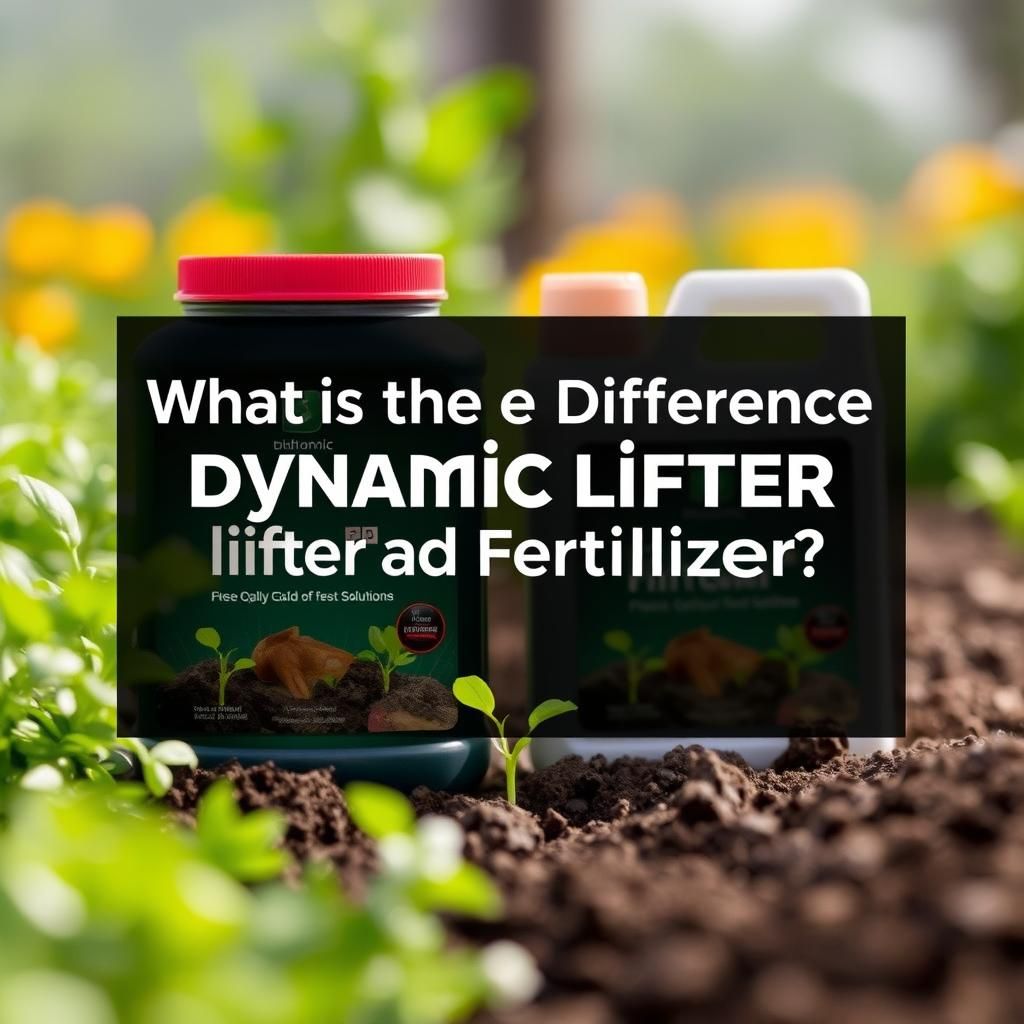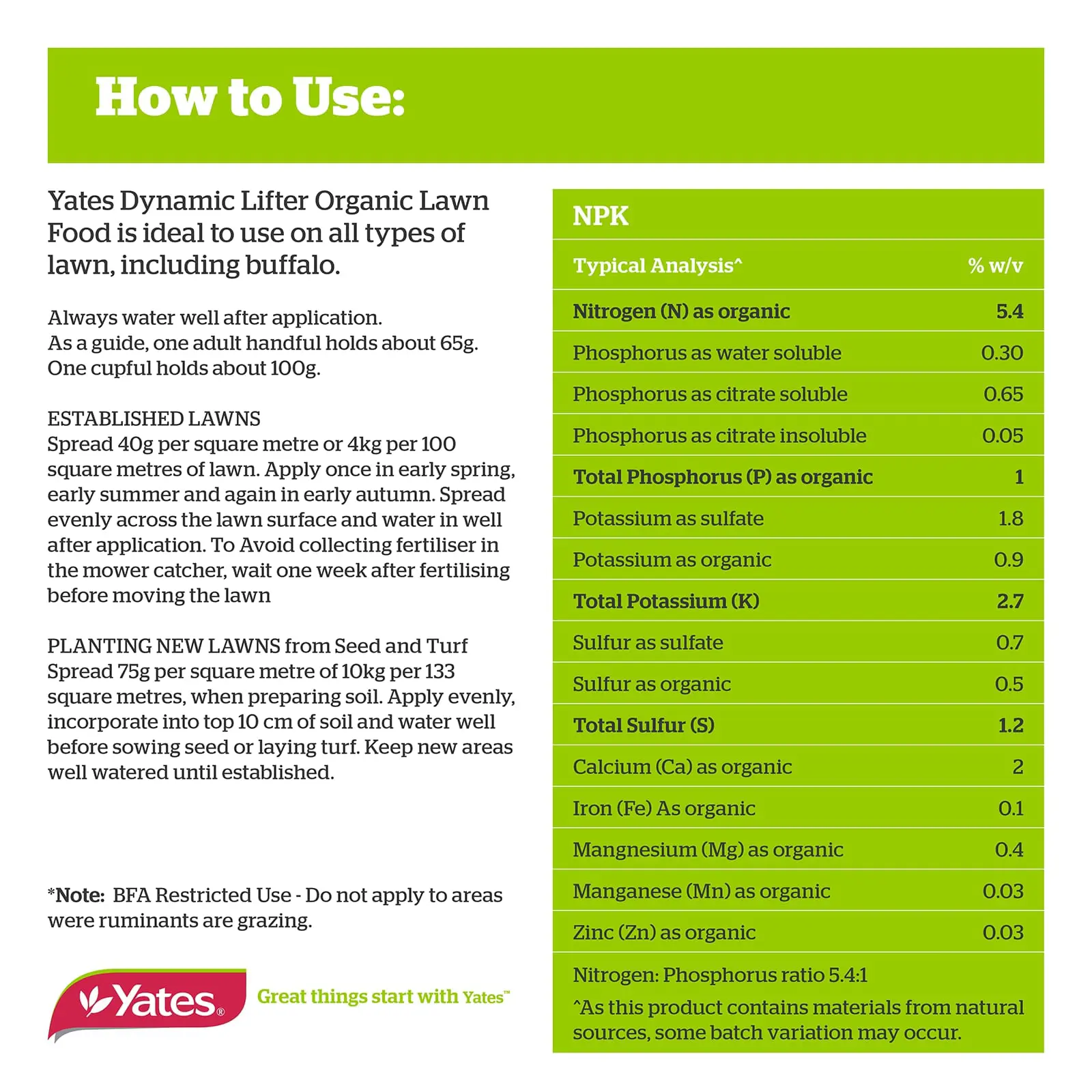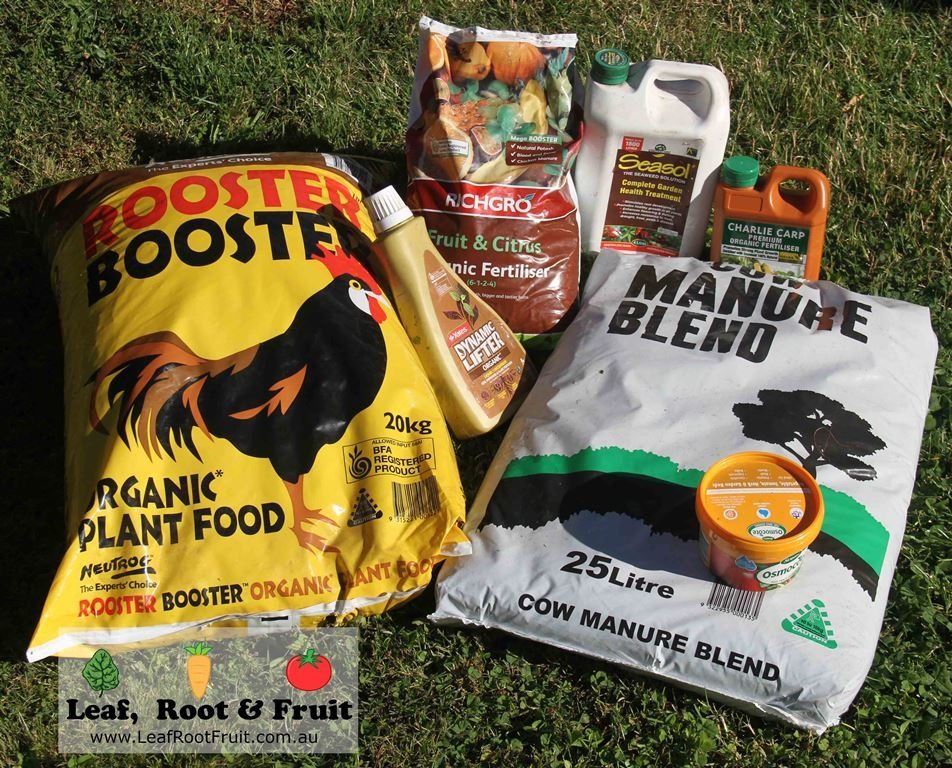What is the Difference Between Dynamic Lifter and Fertiliser? A Comprehensive Guide to Nutrient Solutions

Understanding the distinction between dynamic lifter and traditional fertiliser is essential for gardeners and agricultural enthusiasts alike. While both products serve the primary function of enhancing soil fertility and plant growth, they differ significantly in composition, application, and benefits. Dynamic lifter, often derived from natural materials, provides a slow-release nutrient solution that promotes soil health over time. On the other hand, fertilisers may encompass a variety of chemical or organic compounds designed for immediate nutrient availability. This comprehensive guide will explore these differences in detail, helping you choose the best nutrient solution for your gardening or farming needs.
What is the Difference Between Dynamic Lifter and Fertiliser?
Dynamic Lifter and conventional fertilisers serve different purposes in enhancing soil health and promoting plant growth. Dynamic Lifter is an organic fertiliser derived mainly from chicken manure and is designed to improve soil structure and enhance microbial activity, making it ideal for vegetative growth. On the other hand, fertilisers are chemical or organic products that provide specific nutrients—such as nitrogen, phosphorus, and potassium—to plants. The key distinction lies in Dynamic Lifter's focus on enriching the soil's microbiome and structure, while traditional fertilisers typically deliver a quick nutrient boost but may not improve soil health over the long term.
Composition of Dynamic Lifter
Dynamic Lifter typically consists of organic matter from decomposed poultry manure, which is rich in nutrients such as nitrogen, phosphorus, and potassium. The unique composition of Dynamic Lifter not only enriches the soil but also promotes beneficial microorganisms that assist in the breakdown of organic matter, thereby enhancing nutrient availability for plants. This organic origin makes it an environmentally friendly option for those seeking sustainable gardening practices.
Nutrient Release Rate
The nutrient release rate is a crucial aspect in understanding the difference between Dynamic Lifter and conventional fertilisers. Dynamic Lifter is known for its slow-release properties, which means it gradually delivers nutrients to plants over time. This slow method helps prevent nutrient leaching and promotes sustained plant growth. In contrast, traditional fertilisers often provide a quick nutrient release, leading to rapid plant absorption but with the potential risk of nutrient runoff and soil depletion.
Impact on Soil Health
When considering soil health, Dynamic Lifter plays a significant role by improving soil structure and enhancing its microbial activity. The organic material in Dynamic Lifter helps retain moisture, reduces compaction, and fosters a thriving ecosystem of beneficial organisms. Conversely, while fertilisers can provide immediate nutrient input, they may not contribute positively to long-term soil health and can sometimes lead to soil degradation if used excessively.
Application Methods
The methods of application for Dynamic Lifter and conventional fertilisers also differ. Dynamic Lifter is typically applied as a top dressing or mixed into the soil before planting to ensure a steady supply of nutrients. It is often recommended to be applied during the growth phase of plants. On the other hand, fertilisers can be applied in various forms—granular, liquid, or foliar—depending on the requirements of the plants and the nutrient content needed at specific stages of their growth.
Environmental Considerations
Environmental impact is another important factor distinguishing Dynamic Lifter from traditional fertilisers. Being an organic product, Dynamic Lifter aligns well with sustainable agricultural practices, reducing chemical input and the risk of soil and water contamination. In comparison, traditional fertilisers can lead to runoff and nutrient pollution, contributing to issues such as algal blooms in water bodies. The preference for one over the other often hinges on the values of sustainability and environmental stewardship.
| Aspect | Dynamic Lifter | Fertiliser |
|---|---|---|
| Composition | Organic matter from poultry manure | Chemical or organic compounds |
| Nutrient Release | Slow release | Fast release |
| Soil Health | Enhances structure and microbial activity | May degrade soil if overused |
| Application Methods | Top dressing or soil mixing | Granular, liquid, or foliar |
| Environmental Impact | Sustainable and eco-friendly | Can cause nutrient pollution |
Is dynamic lifter the same as fertilizer?

Dynamic lifter is not precisely the same as standard fertilizer, though it shares some similarities. It is a natural organic fertilizer primarily made from chicken manure, which provides a rich source of nutrients to plants. Dynamic lifter is known for its ability to enhance soil health and promote overall plant growth by improving soil structure and nutrient availability.
Composition of Dynamic Lifter
Dynamic lifter mainly consists of organic materials derived from poultry waste. Its composition typically includes:
- Nitrogen - supports healthy leaf and stem growth.
- Phosphorus - essential for root development and flowering.
- Potassium - vital for overall plant health and stress resistance.
This organic composition differentiates it from synthetic fertilizers, which may contain chemical additives.
Benefits of Using Dynamic Lifter
The usage of dynamic lifter offers various benefits for gardening and agriculture:
- Soil Improvement - enriches soil structure and enhances moisture retention.
- Long-Lasting - provides nutrients over an extended period compared to conventional fertilizers.
- Environmentally Friendly - being organic, it minimizes negative environmental impacts.
These benefits make dynamic lifter an appealing option for organic gardening enthusiasts.
Comparison to Traditional Fertilizers
When comparing dynamic lifter to traditional fertilizers, several key differences arise:
- Source - dynamic lifter is organic, while traditional fertilizers can be synthetic.
- Nutrient Release - dynamic lifter releases nutrients slowly, promoting sustained plant growth.
- Application - traditional fertilizers may require more frequent applications due to quick nutrient depletion.
This comparison highlights the benefits of choosing dynamic lifter for specific gardening practices.
See also:
Usage Guidelines for Dynamic Lifter
To maximize the effectiveness of dynamic lifter, it's important to follow proper usage guidelines:
- Application Rate - typically applied at a rate of 1kg per square meter.
- Timing - best applied during the growing season for optimal nutrient absorption.
- Integration - incorporate into the soil before planting or alongside existing plants.
These guidelines help ensure that the dynamic lifter provides the intended benefits to the soil and plants.
Potential Drawbacks of Dynamic Lifter
Despite its advantages, dynamic lifter may have some drawbacks:
- Odor - the organic nature can produce a noticeable smell during application.
- Pest Attraction - may attract certain pests due to its organic composition.
- Cost - often more expensive than some synthetic fertilizers.
Awareness of these potential issues can help users make informed decisions when selecting fertilizers for their gardens.
What not to use dynamic lifter on?

Dynamic Lifter is an organic fertilizer that is often used to improve soil health and promote plant growth. However, there are certain situations and types of plants where it is not recommended to use Dynamic Lifter. Understanding these limitations can prevent potential harm to your garden or farm.
1. Avoid Using Dynamic Lifter on Seedlings
Using Dynamic Lifter on seedlings can be detrimental due to its strong nutrient concentration. Seedlings have delicate root systems that can be overwhelmed by the high levels of nutrients, leading to burned roots and stunted growth. It's advisable to wait until plants are more established before applying this type of fertilizer.
- Seedlings are more susceptible to nutrient burn.
- Roots may become damaged, inhibiting growth.
- Delay fertilization until plants are established.
2. Do Not Apply to Acid-Loving Plants
Dynamic Lifter can alter the pH of the soil, making it less suitable for acid-loving plants such as azaleas, rhododendrons, and blueberries. These plants prefer acidic soil, and the introduction of Dynamic Lifter can lead to nutrient imbalances and poor health.
- Acidic soil is crucial for the health of these plants.
- pH changes can result in nutrient deficiencies.
- Choose fertilizers specifically designed for acid-loving plants.
3. Refrain from Using in Container Gardens
In container gardens, the soil volume is much smaller, which makes it easier for nutrients to concentrate to harmful levels. Using Dynamic Lifter can cause excessive nutrient buildup, leading to poor drainage and root health issues.
- Small soil volume increases risk of nutrient concentration.
- Poor drainage can lead to root rot.
- Consider controlled-release fertilizers for container gardens.
4. Not Suitable for Established Plants During Dormancy
Applying Dynamic Lifter to established plants during their dormant phase can negatively affect their natural growth cycle. During dormancy, plants are not actively taking up nutrients, which can lead to excess nutrients remaining in the soil and potentially causing harm when they resume growth.
- Plants need to rest without additional nutrients.
- Excess soil nutrients can be detrimental when growth resumes.
- Wait until growing season to apply fertilizers.
5. Avoid on Overly Wet or Saturated Soils
Dynamic Lifter should not be applied to overly wet or saturated soils as this can prevent proper nutrient absorption and may lead to runoff or leaching. In such conditions, the fertilizer may not be effective and can harm soil biology.
- Waterlogged soil prevents nutrient uptake.
- Risk of nutrient runoff can lead to environmental issues.
- Wait for drier conditions to apply fertilizers effectively.
What is the highest rated lawn fertilizer?

The highest rated lawn fertilizer often varies based on factors such as grass type, soil condition, and specific lawn care needs, but one brand frequently recognized for its quality is Milorganite. This organic, slow-release nitrogen fertilizer has received high praise from both professional landscapers and homeowners alike due to its effectiveness and environmentally friendly composition.
Milorganite has an N-P-K ratio of 6-2-0, providing a balanced supply of nutrients that improves soil health and promotes robust grass growth without the risk of burning even during dry conditions. This fertilizer also enhances the microbial activity in the soil, which is crucial for nutrient absorption.
Benefits of Using Milorganite
Milorganite offers several benefits that contribute to its high rating among lawn fertilizers:
See also:
- Environmental Safety: Being made from recycled organic material, it is safe to use around pets and children.
- Slow-Release Formula: This helps prevent nutrient runoff and keeps feeding plants over an extended period.
- Improves Soil Quality: The organic matter enhances soil structure and encourages beneficial microorganisms.
Alternative High-Rated Lawn Fertilizers
While Milorganite is highly rated, there are other fertilizers that also receive attention for their effectiveness:
- Scotts Turf Builder: Known for its reliable results in achieving a thick, green lawn.
- Espoma Organic Lawn Food: Another organic option that nourishes grass naturally.
- Jonathan Green Green-Up: Praised for its fast-acting formula that boosts grass color and health.
Choosing the Right Fertilizer for Your Lawn
Selecting the right fertilizer depends on various factors. Consider the following:
- Grass Type: Different types of grass have specific nutrient needs.
- Soil Test Results: Conducting a soil test can help determine nutrient deficiencies.
- Seasonal Timing: Apply fertilizers according to the growth cycles of your grass for optimal results.
Application Techniques for Optimal Results
Proper application techniques are essential for maximizing the effectiveness of lawn fertilizers:
- Spread Evenly: Use a spreader to ensure uniform distribution to avoid patchy growth.
- Water After Application: Watering helps activate the fertilizer and encourages nutrient absorption.
- Avoid Over-Fertilization: Too much fertilizer can harm your lawn; always follow recommended guidelines.
Common Mistakes in Lawn Fertilization
Avoiding common pitfalls can improve your lawn care results significantly:
- Ignoring Soil Health: Healthier soil leads to stronger grass; focus on building soil health through organic options.
- Skipping Fall Fertilization: Fall is a crucial time for feeding your lawn to prepare it for winter stress.
- Choosing the Wrong Fertilizer: Always consider your lawn's specific needs before making a selection.
What is the alternative to dynamic lifter?

Dynamic Lifter is an organic fertilizer commonly used in gardening and agricultural practices due to its rich nutrient content. However, there are several alternatives to Dynamic Lifter, each offering different benefits and suitable for various gardening needs.
Organic Alternatives
One of the best alternatives to Dynamic Lifter is an assortment of other organic fertilizers. These options can provide essential nutrients without the use of synthetic chemicals. Some popular organic alternatives include:
- Compost: Rich in nutrients and beneficial microbes, compost improves soil structure and fertility.
- Bone Meal: A great source of phosphorus, promoting strong root development and flowering.
- Fish Emulsion: Provides a quick-release source of nitrogen and trace minerals, ideal for leafy green plants.
Inorganic Fertilizers
Although many gardeners prefer organic methods, there are inorganic fertilizers that can serve as effective alternatives to Dynamic Lifter. These fertilizers typically release nutrients quickly:
- Urea: An excellent source of nitrogen that promotes vigorous plant growth.
- Triple Superphosphate: Provides a high amount of phosphorus, making it beneficial for flowering plants.
- Potassium Sulfate: Supplies essential potassium, which helps enhance overall plant health and disease resistance.
Composting Methods
Implementing various composting methods can be an effective alternative to using Dynamic Lifter. Homemade compost allows gardeners to utilize kitchen scraps and yard waste while enriching the soil:
- Hot Composting: Quick decomposition through high temperatures, producing nutrient-rich compost in a matter of weeks.
- Cold Composting: A slower process that requires minimal management, perfect for less experienced gardeners.
- Vermicomposting: Utilizing worms to break down organic matter, resulting in high-quality organic fertilizer known as vermicast.
Green Manures and Cover Crops
Green manures and cover crops are an excellent way to enhance soil fertility and structure without relying on traditional fertilizers. They can be grown during off-seasons to improve nutrient content:
- Legumes: Plants like clover and vetch fix nitrogen in the soil, enriching it naturally.
- Rye: A popular cover crop that helps prevent erosion and adds organic matter when tilled under.
- Mustard: Known for its ability to suppress weeds and pests while improving soil health.
Slow-Release Fertilizers
Another alternative to Dynamic Lifter is slow-release fertilizers that provide nutrients over an extended period. This slow release helps ensure that plants receive a consistent supply of nutrients:
- Granulated Organic Fertilizers: These are specially formulated to release nutrients slowly, promoting steady growth.
- Coated Inorganic Fertilizers: These fertilizers are coated to dissolve slowly, minimizing nutrient leaching.
- Controlled-Release Fertilizers: Designed for specific types of plants, these products regulate nutrient delivery based on moisture and temperature.
Questions from Our Readers
What is dynamic lifter?
Dynamic Lifter is a highly nutritious organic fertiliser made from decomposed animal manure, typically poultry. It is rich in nitrogen, phosphorus, and potassium, which are essential for plant growth. Dynamic Lifter also improves soil structure and encourages beneficial microbial activity, making it an excellent choice for organic gardening.
What is fertiliser?
Fertiliser is a substance added to soil or plants to supply essential nutrients for growth. There are various types of fertilisers, including organic and inorganic, each containing different ratios of key nutrients such as nitrogen, phosphorus, and potassium. Fertilisers are designed to enhance plant health and productivity.
What is the main difference between dynamic lifter and synthetic fertiliser?
The main difference lies in their composition; dynamic lifter is an organic fertiliser derived from natural sources, while synthetic fertiliser is manufactured through chemical processes. This means dynamic lifter improves soil health over time by enhancing its organic matter, whereas synthetic fertilisers can lead to nutrient runoff and soil degradation.
Can dynamic lifter be used as a complete fertiliser?
Yes, dynamic lifter can be considered a complete fertiliser for many plants, as it contains a balanced amount of nutrients necessary for growth. However, in cases where plants have specific nutrient deficiencies, additional fertilisers may be needed to meet their requirements fully.
See also:

If you want to read more articles like What is the Difference Between Dynamic Lifter and Fertiliser? A Comprehensive Guide to Nutrient Solutions, we recommend you check out our Fertilisers category.
Leave a Reply
Related Articles